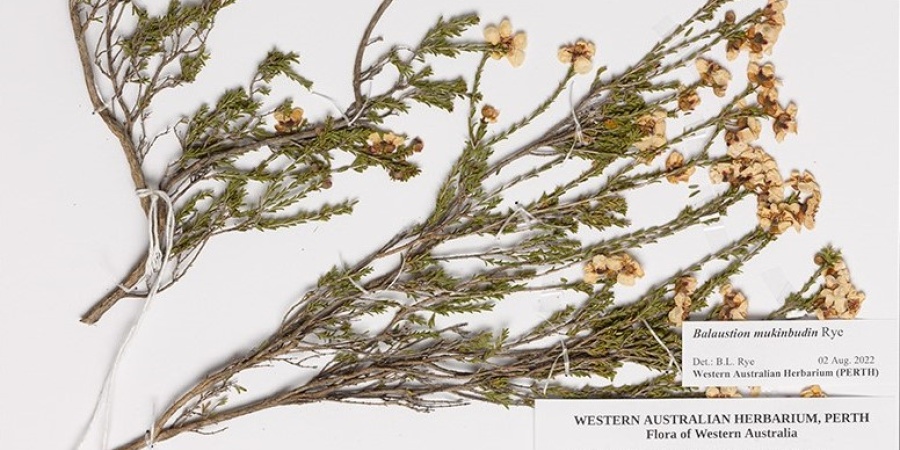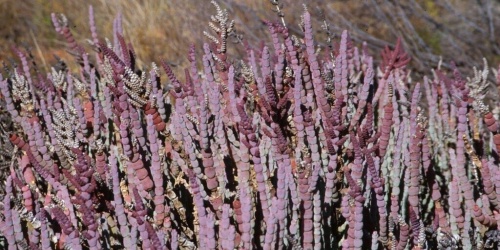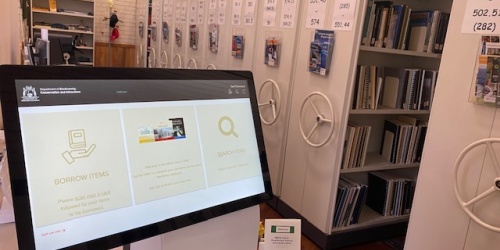
Balaustion mukinbudin Rye specimen
Known by the internationally recognised Herbarium Code 'PERTH', the Western Australian Herbarium houses a collection of more than 845,000 dried specimens of plants, algae, bryophytes (mosses, liverworts and hornworts), lichens, fungi and slime moulds gathered from 1770 to today throughout Western Australia and from across the globe.
These collections with their data and ancillary components (e.g. collection notes, photographs, tissues) are a permanent record of the occurrence of a species at a particular place and time. It forms an irreplaceable source of information and is invaluable research infrastructure for managing and understanding Western Australia’s biodiversity.
The Western Australian Herbarium plays a vital role within the Department of Biodiversity, Conservation and Attractions (DBCA), providing taxonomic names and occurrence information that is essential for biodiversity conservation planning and management. The collection and its data are a dynamic resource, with material continually added to the collection, updated, or reclassified in light of new scientific knowledge. New species are documented each year, often during research using the collection or as a result of botanical field surveys.
Information on the State’s flora is made freely available through the Herbarium’s portal Florabase, the Australasian Virtual Herbarium, and the journal Nuytsia. Staff and associates also maintain an active Facebook page to promote Western Australia’s biodiversity and the activities of Herbarium staff and volunteers
Accessing the collection
The physical collections of the Western Australian Herbarium are accessed by staff botanists and visiting researchers from across the globe for scientific studies including taxonomy, conservation biology, evolution, genetics, ecology, history, forensic science, ethnobotany, archaeology and palynology. The curated biodiversity data associated with the collection is shared and increasingly used in big data ecosystem and climate science. A separate, self-service Reference Herbarium is available to the public to facilitate accurate identification of botanical specimens collected by government, industry and the community.
Researchers intending to visit Australia to collect flora/wildlife should ensure they have the appropriate documented permissions to take and export specimens or samples. For collecting permits for Western Australia, refer to the DBCA Wildlife licencing page.
Public Reference Herbarium
The Reference Herbarium is publicly accessible and the primary resource for community and industry consultants to identify specimens. While the Reference Herbarium is not complete and will at times be insufficient to finalise an identification, it is generally adequate for most needs.
Resources
Reference Herbarium User Guide (PDF)
Herbarium Box Loan Guidelines (PDF)
Research Collections
The Research Collection is a valuable and irreplaceable research infrastructure that underpins flora conservation, biodiversity surveys, and taxonomic and other scientific and cultural research. Scientific botanical specimens are managed to protect their value indefinitely.
Access to the Research Collection can be requested by contacting the Collections Manager via herbarium@dbca.wa.gov.au. Induction training is offered to stakeholders who need frequent or extended access to the Research Collection - visit waherbariuminduction.eventbrite.com.au to see upcoming dates.
Resources
Digital Collection
The Western Australian Herbarium has been completely databased and is available via the following online portals:
- Florabase
- The Australasian Virtual Herbarium
- The Atlas of Living Australia
- The Global Biodiversity Information Facility (GBIF)
- Type specimens via JSTOR Global Plants
Please email herbarium@dbca.wa.gov.au if you need assistance with a specific query.
Some information found on specimens and in our collections datasets contains terms or descriptions that reflect the authors’ views, or those of the period in which the information was written or recorded, but may not be considered appropriate or are culturally sensitive (such as indigenous knowledge, cultural site information), insensitive, or inappropriate today. These views are not necessarily the views of the Department of Biodiversity, Conservation and Attractions and the Western Australian Herbarium. While the information provided may not reflect current understanding and might not normally be used in certain public or community contexts, it is provided in an historical context. Aboriginal and Torres Strait Islander people should be aware that Western Australian Herbarium data contains names of deceased persons.
The Western Australian Herbarium recently acquired a high-resolution camera system to image all of the collections items for online access. Until these are made available, requests for specimen images can be submitted via the Perth Imaging request form.
Tours
Tours for special interest groups may be requested (maximum 15 people per tour) but are restricted. For more information, please contact the Herbarium Curator, John Huisman, by emailing herbarium@dbca.wa.gov.au.
Herbarium loans, exchanges and donations
The Western Australian Herbarium (PERTH) has an active loans, exchanges and destructive sampling program as part of the national and international network of herbaria and institutions sharing plant specimens. Permanent or temporary transfer of biological materials can only occur between PERTH and an eligible receiving institution.
Quarantine and Biosecurity
Quarantine and Biosecurity restrictions apply for all herbarium material sent to Australia and Western Australia. For the safety of the specimens, please contact PERTH by emailing herbarium@dbca.wa.gov.au before sending any material to ensure the correct documentation has been attached to the shipment. Please also refer to BICON for import requirements (e.g., search for \'herbarium specimens\').
Scientific exchange of all CITES listed taxa from and to Australian institutions requires both the Australian and overseas scientific organisations to be CITES registered. Scientific exchange of any Australian native species not listed under CITES requires both import and export institutions to be either CITES-registered or registered with the Australian Government Department of Climate Change, Energy, the Environment and Water (DCCEEW) as part of the Australian Scientific Exchange Program for herbarium specimens or samples. For further details, visit their website.
Resources
PERTH Quarantine guidelines - International (PDF)
PERTH Quarantine guidelines - Interstate (PDF)
Herbarium loan and sampling requests
Researchers wishing to loan specimens from the Western Australian Herbarium must abide by the Herbarium’s Specimen Loan Policy. Destructive sampling of specimens may be requested; please refer to our Destructive Sampling Guidelines.
Resources
PERTH Specimen Loan Policy (PDF)
PERTH Destructive Sampling Guidelines and Agreement (PDF)
Exchange and specimen donation
Herbaria globally have a longstanding tradition of exchanging herbarium specimens for the purpose of broadening collection diversity and increasing local accessibility of specimens for scientific research. We also accept donations of legally gathered collections and orphaned collections for incorporation. The Western Australian Herbarium shares more than 3500 duplicate specimens annually with other institutions globally.
Herbarium label information for exchange specimens can be sent electronically to the receiving organisation in Darwin Core Archive or *.csv formats. We encourage, and appreciate, the full transfer of electronic data with herbarium collections being donated to the Western Australian Herbarium, including permit information.
Resources
PERTH Exchange Guidelines (PDF)
PERTH Acquisition Guidelines (PDF)
Volunteering opportunities at the Herbarium
The Western Australian Herbarium has an active core group of volunteers who assist with the mounting of specimens, image management, and imaging of collections. We couldn't do it without them!
The Western Australian Herbarium does not currently have any open volunteer positions available. If you would like to be notified about future openings, you may register online via this form.
The Herbarium regularly offers internships for university work experience programs including the University of Western Australia Work Integrated Learning and McCusker Centre for Citizenship, and The University of Notre Dame; please contact them or your institution for more information on how to apply. Please visit the DBCA volunteer page for other volunteering options available within the department.
Botanical services
The Western Australian Herbarium offers public and professional services for the identification of botanical specimens and their incorporation and long-term storage within the State Herbarium.
Please note that the submission of plant identification requests to the Herbarium from photographs or digital images alone is discouraged. We recommend submitting such images to iNaturalistAU or other social media community programs for identification.
Requests for specimen images can be submitted via the PERTH Imaging request form.
Resources
PERTH ID and Incorporation Service (PDF)
The Western Australian Herbarium accepts the submission of images of Western Australian floral biodiversity captured in association with vouchered specimen collections.
Resources
Herbarium Image Donation Guide (PDF)
Herbarium Image Donation form (PDF)
Herbarium Image Donation Photograph List (XLS)
Join our mailing list to receive the latest updates from the Western Australian Herbarium.
Additional resources and documents
Interested in how to make a great herbarium collection, or keen to know the ins-and-outs of Herbarium operation? Here are some of our operational documents.
Collecting a research-grade botanical specimen
How to Collect Herbarium Specimens (PDF)
Herbarium collecting sheet (PDF)
PERTH Excel Template for Collection Data (PDF)
PERTH Excel Template for Collection Data (XLS)
Western Australian Herbarium operational documents
PERTH Integrated Pest Management Plan (PDF)
PERTH Mounting Guidelines (PDF)
PERTH Deaccessioning Guidelines (PDF)

